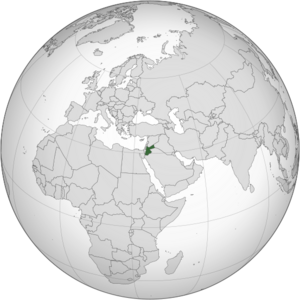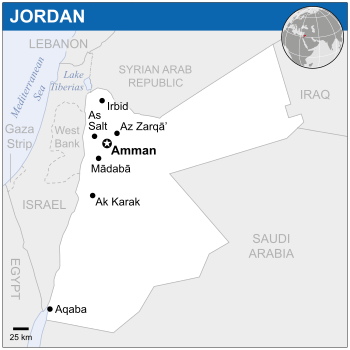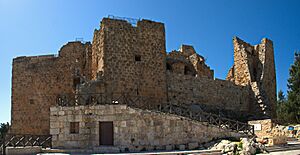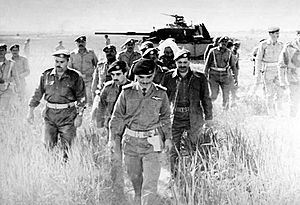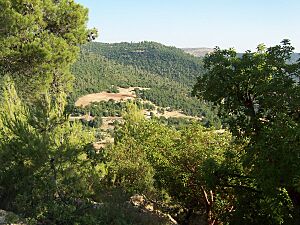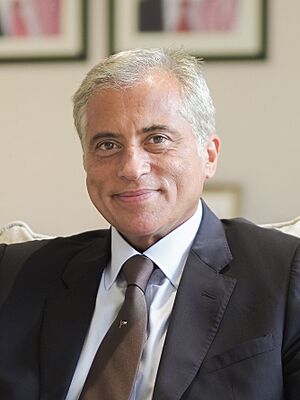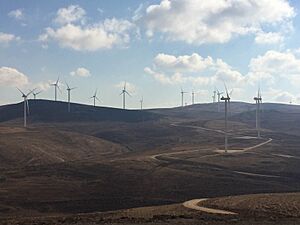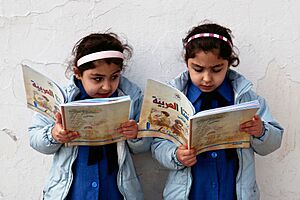Jordan facts for kids
Quick facts for kids
Hashemite Kingdom of Jordan
|
|
|---|---|
|
|
|
|
Motto: الله، الوطن، الملك
Allāh, al-Waṭan, al-Malik "God, Country, King" |
|
|
Anthem: السلام الملكي الأردني
Al-Salām al-Malakī al-Urdunī "The Royal Anthem of Jordan" |
|
| Capital and largest city
|
Amman 31°57′N 35°56′E / 31.950°N 35.933°E |
| Official languages | Arabic |
| Ethnic groups |
|
| Religion | 1% others |
| Demonym(s) | Jordanian |
| Government | Unitary parliamentary constitutional monarchy |
|
• Monarch
|
Abdullah II |
| Jafar Hassan | |
| Legislature | Parliament |
| Senate | |
| House of Representatives | |
| Independence
from the United Kingdom
|
|
|
• Emirate
|
11 April 1921 |
| 25 May 1946 | |
|
• Current constitution
|
11 January 1952 |
| Area | |
|
• Total
|
89,342 km2 (34,495 sq mi) (110th) |
|
• Water (%)
|
0.6 |
| Population | |
|
• 2023 estimate
|
11,484,805 (84th) |
|
• 2015 census
|
9,531,712 |
|
• Density
|
114/km2 (295.3/sq mi) (70th) |
| GDP (PPP) | 2023 estimate |
|
• Total
|
|
|
• Per capita
|
|
| GDP (nominal) | 2023 estimate |
|
• Total
|
|
|
• Per capita
|
|
| Gini (2011) | 35.4 medium |
| HDI (2023) | high · 100th |
| Currency | Jordanian dinar (JOD) |
| Time zone | UTC+3 |
| Driving side | right |
| Calling code | +962 |
| ISO 3166 code | JO |
| Internet TLD | .jo .الاردن |
Jordan, officially known as the Hashemite Kingdom of Jordan, is a country in West Asia. It is located in the Southern Levant region. Jordan shares borders with Syria to the north, Iraq to the east, and Saudi Arabia to the south. To the west, it borders Israel and the occupied Palestinian territories.
The Jordan River flows along the country's western edge, leading into the Dead Sea. Jordan also has a small coastline on the Red Sea in its southwest, near the Gulf of Aqaba. Amman is the capital and largest city, and it is also the biggest city in the Levant region.
People have lived in Jordan since the Paleolithic period (Stone Age). Ancient kingdoms like Ammon, Moab, and Edom developed here. Later, the Nabataeans built their famous kingdom with its capital in Petra. The region was then part of the Greco-Roman world and later Islamic empires. After World War I, Jordan became independent from the United Kingdom in 1946.
Jordan is a mostly dry country, covering about 89,342 square kilometers. It has a population of around 11.5 million people. Most Jordanians (about 95%) are Sunni Muslim. Jordan has welcomed many refugees from nearby countries, including about 2.1 million Palestinian refugees and 1.4 million Syrian refugees. This has put some pressure on the country's resources.
Jordan is a constitutional monarchy, meaning it has a king who shares power with a parliament. It is a member of the Arab League and the Organisation of Islamic Cooperation. Jordan has a high Human Development Index and a growing economy, especially in tourism and healthcare.
Contents
What's in a Name?
Jordan gets its name from the Jordan River, which forms part of its northwestern border. The name likely comes from the Hebrew word Yarad, meaning "the descender." This describes how the river flows downwards.
Long ago, the area that is now Jordan was called Transjordan. This means "across the Jordan River." Early Arab writings called the river Al-Urdunn, which is similar to the Hebrew name.
Jordan's Story Through Time
Ancient Times
The earliest signs of human life in Jordan go back at least 200,000 years. Scientists found the oldest evidence of bread-making here, dating back 14,500 years!
During the Neolithic period (10,000–4,500 BC), people started living in farming villages instead of hunting and gathering. One of the largest ancient villages in the Near East was 'Ain Ghazal, near modern-day Amman. Amazing plaster statues of humans from around 7250 BC were found there.
Later, in the Bronze Age (3600–1200 BC), fortified towns appeared. Jordan became a center for copper mining. During the Iron Age (1200–332 BC), three kingdoms existed in Transjordan: Ammon, Edom, and Moab. These kingdoms often fought with the Hebrew kingdoms to the west.
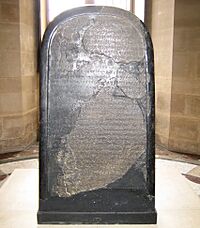
The Mesha Stele, a famous stone monument from 840 BC, tells about the Moabite King Mesha's building projects and his victory against the Israelites. This stele is an important link to stories in the Bible. Eventually, these kingdoms were taken over by larger empires like the Assyrians and Babylonians.
Roman and Byzantine Rule
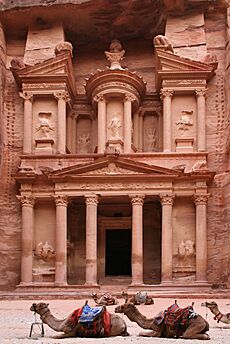
Around 332 BC, Alexander the Great conquered the region, bringing Greek culture. After his death, the area was often fought over by Greek empires. The Nabataeans, an Arab group, built their own kingdom in 169 BC. Their capital, Petra, became very rich from controlling trade routes. They were skilled stone carvers, creating amazing buildings like Al-Khazneh.
In 63 BC, the Roman Empire took control. They built new roads and gave some cities, like Jerash, special freedom. Jerash is one of the best-preserved Roman cities in the East.
When the Roman Empire split in 324 AD, the Eastern Roman Empire (the Byzantine Empire) continued to rule. Christianity became the official religion. Many Christian churches were built in Jordan during this time. The Aqaba Church is believed to be the world's first church built specifically for Christian worship.
Islamic Empires
In 636 AD, Muslim forces defeated the Byzantines, and Jordan became part of the Islamic caliphates. The Umayyad Caliphate (661–750) built beautiful desert castles in Jordan, like Qasr Al-Mshatta.

Later, the Abbasid Caliphate took over, moving the capital to Baghdad. Jordan became less important for trade. After the Abbasids, Jordan was ruled by the Fatimid Caliphate and then by the Crusaders. The Crusaders built castles like Montreal and Al-Karak.
In 1187, the Muslim leader Saladin defeated the Crusaders. His Ayyubid dynasty built Ajloun Castle and used older castles to fight the Crusaders. These castles also became important stops for Muslim pilgrims traveling to Mecca. The Mamluks later expanded these castles.

The Ottoman Empire took control in 1516. For a long time, the Ottomans had little presence in Jordan, leading to a period of disorder. In the 19th century, the Ottomans tried to regain control, building the Hejaz Railway in 1908. This railway helped the economy by making Jordan a stop for pilgrims.
Modern Jordan
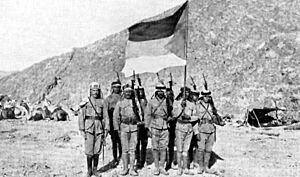
During World War I, the Arab Revolt began in 1916, led by Sharif Hussein and his sons. This revolt ended four centuries of Ottoman rule. The British and French had secretly agreed to divide the region, which disappointed Arab hopes for a unified state.
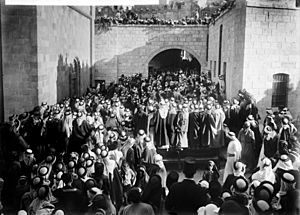
In 1920, Abdullah, Sharif Hussein's son, arrived in Jordan. He worked to establish an organized government. The British reluctantly accepted him as ruler. On April 11, 1921, the Emirate of Transjordan was formed, with Abdullah as its emir.
Transjordan remained a British mandate until 1946. On May 25, 1946, the country gained full independence and became the Hashemite Kingdom of Jordan. This day is now celebrated as Independence Day.
In 1948, Jordan joined other Arab states in a war with Israel. After the war, Jordan controlled the West Bank. King Abdullah I was killed in 1951. His grandson, Hussein, became king in 1953.
In 1967, Jordan lost control of the West Bank to Israel during the Six-Day War. A conflict followed, including the 1968 Battle of Karameh, where Jordanian forces and Palestinian groups fought off an Israeli attack. In 1988, Jordan gave up its claim to the West Bank to the Palestinians.
Jordan signed a peace treaty with Israel in 1994. In 1999, Abdullah II became king after his father Hussein passed away. King Abdullah II focused on improving Jordan's economy.
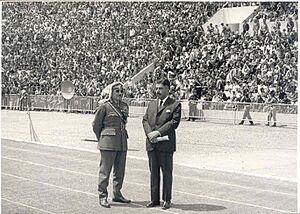
In 2005, there were attacks in Amman, causing many deaths. Jordan's security has greatly improved since then. The Arab Spring protests in 2011 caused instability in many Arab countries. Jordan managed to avoid widespread violence, even with many Syrian refugees arriving. King Abdullah II introduced reforms to the constitution and election laws.
Jordan's Landscape

Jordan is located where Asia, Africa, and Europe meet. It covers about 89,341 square kilometers. To the south and east is Saudi Arabia, to the northeast is Iraq, and to the north is Syria. To the west are Israel and Palestine (the West Bank).
The eastern part of Jordan is a dry plateau with oases and seasonal streams. Most major cities are in the northwestern part, where the soil is fertile and there is more rainfall. These cities include Amman, Irbid, and Zarqa.
In the west, there are highlands with farmland and forests. This area drops sharply into the Jordan Rift Valley, which holds the Jordan River and the Dead Sea. The Dead Sea is the lowest point on Earth. Jordan has a small coastline on the Gulf of Aqaba in the Red Sea.

Jordan has many different natural environments. The Royal Society for the Conservation of Nature works to protect Jordan's wildlife and natural resources.
Weather and Climate
Jordan's climate changes a lot. The further inland you go from the Mediterranean Sea, the bigger the temperature differences and the less rain there is. The average elevation is 812 meters above sea level.
The highlands in the west have a Mediterranean climate with mild, wet winters and hot, dry summers. The eastern and northeastern areas are dry deserts. Even though deserts get very hot, the heat is often made more comfortable by low humidity and a breeze. Nights in the desert are cool.
Summers, from May to September, are hot and dry, with temperatures often reaching over 40°C in July and August. Winters, from November to March, are cooler, with average temperatures around 11°C. Winter also brings rain and sometimes snow in the western mountains.
Plants and Animals
Over 2,000 types of plants have been found in Jordan. Many flowering plants bloom in spring after the winter rains. The type of plants depends on how much rain an area gets. Forests grow in the mountainous northwest, but further south and east, the plants become more like scrub and desert plants. Forests cover less than 2% of Jordan, which is very low compared to the rest of the world.
Animals found in Jordan include the Nubian ibex, wild boar, Arabian wolf, and caracal. Many birds also live here, such as the hooded crow, hoopoe, and Palestine sunbird.
How Jordan is Governed
Jordan is a constitutional monarchy, meaning it is a country with a king and a constitution. The constitution, adopted in 1952, sets out how the king, government, parliament, and courts work. The king has a lot of power in running the country and making laws.
The king is the head of state and the leader of the Jordanian Armed Forces. He can declare war, approve laws, and dismiss the government. The government is appointed by the king and is responsible to the parliament.
Jordan's parliament has two parts: the Senate and the House of Representatives. The king appoints the 65 members of the Senate. The 130 members of the House of Representatives are elected by the people for a four-year term. There are special seats in the House for women, Christians, and Circassians/Chechens.
The courts in Jordan are divided into civil, religious, and special courts. While Islam is the official religion, the constitution protects religious freedom.
King Abdullah II became king in February 1999. He has worked to improve Jordan's economy and its relationships with other countries. His eldest son, Prince Hussein, is the Crown Prince. The current prime minister is Jafar Hassan.
Jordan's Economy
Jordan is considered a lower middle-income country. It does not have many natural resources or much land for farming. About 15.7% of the population lived below the poverty line in 2018.
The economy has grown steadily over the years. Jordan's economy is one of the smaller ones in the region. However, it has a skilled workforce, which attracts foreign investors.
The main currency is the Jordanian dinar. Jordan joined the World Trade Organization in 2000 and has a free trade agreement with the United States.
The global economic downturn and regional conflicts have affected Jordan's economy. For example, attacks on the natural gas pipeline from Egypt forced Jordan to use more expensive fuels. The cost of hosting many refugees has also put a strain on the country's finances.
Jordan has a good education system, which means it has many well-educated and skilled workers. This has helped attract foreign investments and allowed Jordanians to work in other countries, sending money back home.
Getting Around Jordan
Jordan has good infrastructure, especially its roads. This is important because Jordan is a transit country for goods and services to Palestine and Iraq.
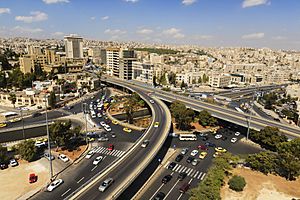
The country has a large road network. The historic Hejaz railway, built during the Ottoman Empire, is mainly used for transporting goods today. There are plans to expand the railway system in the future. Amman has public buses, and there are bus rapid transit systems connecting cities.
Jordan has three airports for international flights. Two are in Amman, and one is in Aqaba. Queen Alia International Airport in Amman is the main international airport and a hub for Royal Jordanian Airlines. It was expanded in 2013 and is considered a modern airport.
The Port of Aqaba is Jordan's only seaport. It is an important port for trade in the region.
Exploring Jordan: Tourism
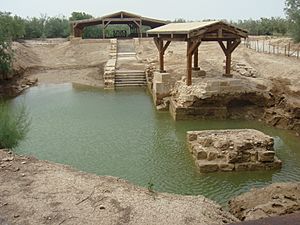
Tourism is a very important part of Jordan's economy. It provides many jobs and brings in money. In 2010, 8 million people visited Jordan. However, regional conflicts caused a big drop in tourist numbers, but they started to recover in 2017.
Jordan has about 100,000 archaeological and tourist sites. Famous historical cities include Petra and Jerash. Petra is the most popular attraction and a symbol of Jordan.
As part of the Holy Land, Jordan has many biblical sites, such as Al-Maghtas (where Jesus is believed to have been baptized) and Mount Nebo. There are also Islamic sites, like shrines of the prophet Muhammad's companions. Ajloun Castle, built by Saladin in the 12th century, is also a popular place to visit.
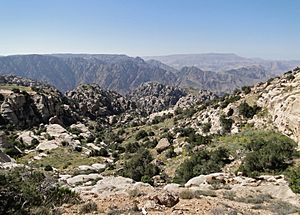
Modern cities, especially Amman, offer entertainment and shopping. Hiking is becoming popular, with places like Dana Biosphere Reserve and Petra offering many trails. The Jordan Trail is a 650-kilometer hiking path that goes across the entire country.
Jordan is also known for medical tourism. Many people from other countries come to Jordan for medical treatment because of its good healthcare system. The Dead Sea is a natural resort, famous for its very salty water, which is good for skin conditions.
Natural Resources
Jordan is one of the most water-scarce countries in the world. It has very limited water resources, and the large number of refugees has made this problem worse. Jordan shares its main rivers, the Jordan and Yarmuk, with neighboring countries.
Natural gas was found in Jordan in 1987, but the reserves are small. This means Jordan relies heavily on importing oil for electricity. To solve this, Jordan built a port for liquified natural gas and is working to use more renewable energy.
Jordan gets 330 days of sunshine a year, and it has good wind speeds, making renewable energy promising. Large wind and solar power plants have been built. By early 2019, renewable energy provided 8% of Jordan's electricity, and the goal is to reach 20%.
Jordan has the fifth-largest oil-shale reserves in the world. It also has large uranium reserves and is looking into using nuclear energy for power and water desalination. Phosphate mines in the south make Jordan one of the world's largest producers and exporters of this mineral.
Industries in Jordan
The industrial sector includes mining, manufacturing, construction, and power. Main industrial products are potash, phosphates, cement, clothes, and fertilizers. Jordan is a leading maker of medicines in the Middle East.
The military industry has also grown. The Jordan Design and Development Bureau (JODDB) was created in 1999 to develop military products for the Jordanian Armed Forces and for export.
Science and New Technologies
Science and technology are growing fast in Jordan, especially in information and communications technology (ICT) and nuclear technology. Jordan creates 75% of the Arabic content on the Internet. The ICT sector provides many jobs and contributes a lot to the country's economy.
Jordan has its first nuclear reactor, the Jordan Research and Training Reactor, which opened in 2016. It is used for training students and producing medical isotopes.
Jordan also hosts the Synchrotron-Light for Experimental Science and Applications in the Middle East (SESAME) facility. This is the only particle accelerator in the Middle East and helps scientists from different countries work together.
People and Culture
Population and Diversity
In 2015, Jordan's population was about 9.5 million. About 30% of the people were not citizens, including refugees. Most Jordanians (about 98%) are Arabs. The remaining 2% include people from the Caucasus, like Circassians, Armenians, and Chechens. Most of the population lives in cities.
Jordan has welcomed many refugees over the years. As of 2016, there were over 2 million Palestinian refugees, most of whom have Jordanian citizenship. After the 2003 Iraq War, many Iraqis moved to Jordan, and some Iraqi Christians settled there. Since 2010, over 1.4 million Syrian refugees have come to Jordan, with many living in the Zaatari refugee camp.

Religions in Jordan
Sunni Islam is the main religion in Jordan, followed by about 95% of the population.
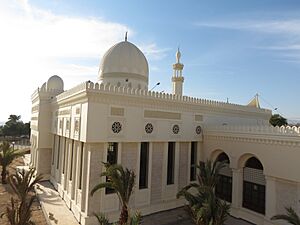
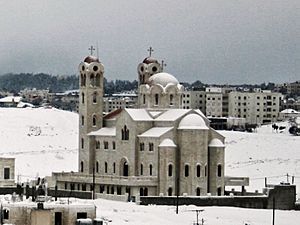
Jordan has some of the oldest Christian communities in the world, dating back to the 1st century AD. Christians make up about 4% of the population today. They are well-integrated into society and have a lot of freedom.
Smaller religious groups include Druze, Baháʼís, and Mandaeans.
Languages Spoken
The official language is Modern Standard Arabic, which is taught in schools. Most Jordanians speak a local dialect called Jordanian Arabic. English is widely spoken and used in business and banking. Many university classes are taught in English. Other languages like Chechen, Circassian, and Armenian are spoken by their communities.
Health and Learning
Life expectancy in Jordan was about 74.8 years in 2017. The main causes of death are heart diseases and cancer. Childhood immunizations have increased, reaching over 95% of children under five by 2002. Access to clean water and sanitation has also greatly improved.
Jordan has some of the best healthcare services in the region. The King Hussein Cancer Center is a leading cancer treatment center. Most Jordanians have medical insurance.
The education system includes pre-school, 10 years of basic education, and two years of secondary education. Primary education is free. Jordan has a very high literacy rate, one of the highest in the Middle East and the world. It also ranks high in providing equal education for boys and girls.
Jordan has many public and private universities and colleges. Over 200,000 students enroll in universities each year.
Jordanian Culture
Arts and Museums
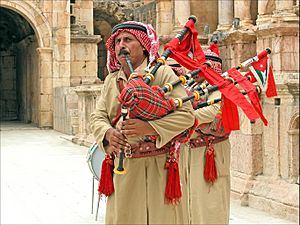
Many organizations work to promote Jordanian art in painting, sculpture, and photography. The art scene has grown, and Jordan has become a place for artists from nearby countries. In 2016, a Jordanian film called Theeb was nominated for an Academy Award.
The largest museum is The Jordan Museum, which holds important archaeological finds like parts of the Dead Sea Scrolls. Other museums include The Children's Museum Jordan and the Royal Automobile Museum. The Jordan National Gallery of Fine Arts shows modern art.
Jordanian music is also growing, with many popular bands and artists. The Jerash Festival is an annual music event. There are also many alternative Arabic rock bands.
Jordan opened its first underwater military museum off the coast of Aqaba, featuring military vehicles underwater.
Delicious Food
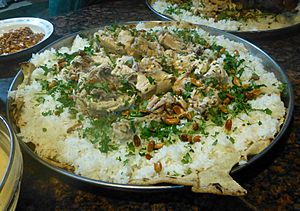
Jordan is a big producer of olives, so olive oil is the main cooking oil. Common appetizers include hummus (chickpea puree) and ful medames (fava beans). A typical meze (small dishes) might have koubba maqliya (fried meatballs), labaneh (strained yogurt), and tabbouleh (salad). These are often served with arak, a traditional alcoholic drink.
The most famous dish is mansaf, the national dish of Jordan. It is a symbol of hospitality. Mansaf is a plate of rice with meat cooked in thick yogurt, often topped with pine nuts. It is traditionally eaten with hands. For dessert, people enjoy sweets like baklava and knafeh. Drinking coffee and tea is also very common.
Sports and Games
Jordan has achieved great success in taekwondo. At the 2016 Summer Olympics, Ahmad Abughaush won Jordan's first-ever Olympic medal, a gold in taekwondo. This has made taekwondo very popular, along with football and basketball.
Football is the most popular sport. The national football team has done well in Asian competitions. Jordan also encourages girls and women to play sports. In 2016, Jordan hosted the 2016 FIFA U-17 Women's World Cup, the first women's sports tournament in the Middle East.
Basketball is another strong sport for Jordan. The national basketball team has competed in the FIBA Basketball World Cup. Other popular sports include boxing, karate, and kickboxing.
See also
 In Spanish: Jordania para niños
In Spanish: Jordania para niños




